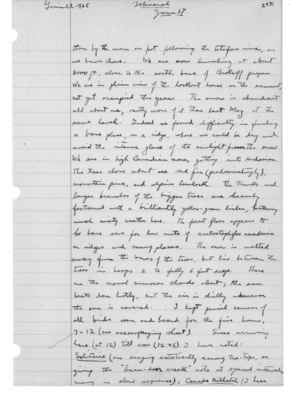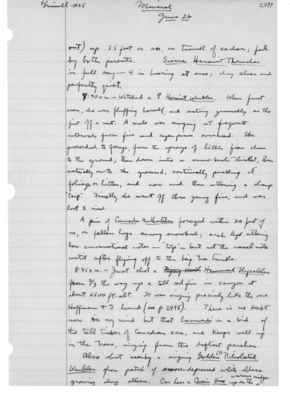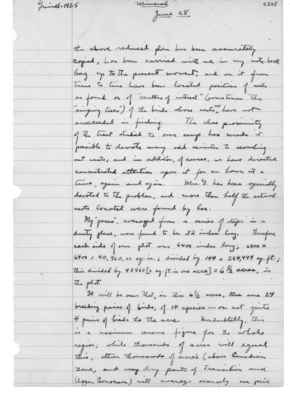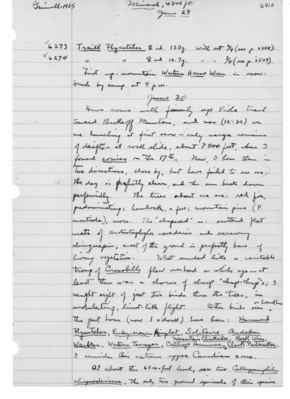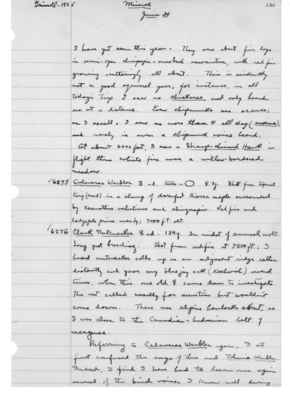Pages That Mention Canadian Zone
1925: Joseph Grinnell's field notes
S2 Page 15
Collector: Grinnell - 1925 Location: Lassen Section (Mineral) Date: June 17, 1925 Page Number: 2471
then by the man on foot following the telephone wire, as we have done. We are now leveling at about 8000 ft., close to the south base of Brokeoff proper. We are in plain view of the lookout house on the summit, not yet occupied this year. The snow is abundant all about us, vastly more of it than last May at the same level. Indeed we found difficulty in finding a bare place, or a ridge, where we could be dry and avoid the intense glare of the sunlight from the snow. We are in high Canadian zone, getting into Hudsonian. The trees close about are red fir (predominantly), mountain pine, and alpine hemlock. The trunks and larger branches of the bigger trees are heavily festooned with a brilliantly yellow-green lichen, betokening much misty weather here. The forest floor appears to be bare save for low mats of arctostaphylos nevadensis on ridges and sunny places. The snow is melted away from the bases of the trees, but lies between the trees in heaps 2 to fully 6 feet deep. There are the usual summer clouds about; the sun beats down hotly, but the air is chilly whenever the sun is covered. I kept pencil census of all birds seen and heard for the five hours, 7-12 (see accompanying sheet). Some arriving here (at 12) till now (12:45) I have noted: Solitaire (one singing extatically among tree-tops, or giving the "barn-door creak" note at spaced intervals, many in slow sequence); Canada Nuthatch (I hear
S2 Page 43
Collector: Grinnell - 1925 Location: Mineral Date: June 26 Page Number: 2497
out) up 35 feet or so, on trunk of cedar; fed by both parents. Sierra Hermit Thrushes in full song - 4 in hearing at once, day clear and perfectly quiet.
7:40 a.m. - Watched a [female symbol] Hermit Warbler. When first seen, she was fluffing herself, and attacking generally as tho just off a nest. A male was singing at frequent intervals from fir and sugar pines overhead. She proceeded to forage, from the sprays of little fir close to the ground; then down into a snow-bush thicket, then actually on to the ground, continually picking at foliage or litter, and now and then uttering a sharp "tsip." Finally she went off thru young firs, and was lost to view.
A pair of Canada Nuthatches foraged within 20 feet of us, on fallen logs among snowbush; each kept uttering low conversational notes "Tiys" - but not the nasal note until after flying off to the big tree trunks.
8:45 a.m. - Just shot a Pygmy Nuth Hammond Flycatcher from 2/3 the way up a all red fir in canyon at about 6500 ft. alt. It was singing precisely like the one Hoffmann & I heard (see p. 2495). There is no doubt now in my mind but that hammondi is a bird of the tall timber of Canadian zone, and keeps well up in trees, singing from the loftiest perches.
Also shot a singing Golden ^(?) Pileolated Warbler from batch of snow-depressed white alders growing along the stream. Can hear a Cassin Vireo up on the ^warmer ridge.
S2 Page 51
Collector: Grinnell - 1925 Location: Mineral Date: June 28 Page Number: 2505
the above reduced plan has been accurately copied, has been carried with me in my note-book bag up to the present moment, and on it from time to time have been located positions of nest as found or of "centers of interest" (sometimes the "singing trees") of the birds whose nests we have not succeeded in finding. The close proximity of the tract studied to our camp has made it possible to devote many odd minutes to searching out nests; and in addition, of course, we have directed concentrated attention upon it for an hour at a time, again and again. Mrs. G. has been specially devoted to the problem, and more than half the actual nests located were found by her.
My "paces", averaged from a series of steps in a dusty place, were found to be 32 inches long. Therefore each side of our plot was 6400 inches long; 6400 x 6400 = 40,960,00 [sic] sq. in; divided by 144 = 284,444 sq. ft.; this divided by 43560 [= sq. ft. in one acre] = 6 1/2 acres, in the plot.
It will be seen that, in this 6 1/2 acres, there were 24 breeding pairs of birds, of 14 species - or not quite 4 pairs of birds to the acre. Undoubtedly, this is a maximum census figure for the whole region; while thousands of acres will equal this, other thousands of acres (above canadian zone, and very dry parts of Transition and Upper Sonoran) will average scarcely one pair
S2 Page 57
Collector: Grinnell - 1925 Location: Mineral, 4800 ft. Date: June 29 Page Number: 2510
6273 Traill Flycatcher [female symbol] ad. 13.0 g. with set 3/4 (see p. 2508). 6274 Traill] [Flycatcher] [female symbol] ad. 12.7 g. [with] [set] 3/4 (see p. 2509).
First up - mountain Western House Wren in snow brush by camp at 4 p.m.
June 30 Have come with family up Viola trail towards Brokeoff Mountain, and now (12:30) we are lunching at first snow - only meagre remains of drifts - at rock slide, about 7500 feet, where I found conies on the 17th. Now, I hear them in two directions, close by, but have failed to see one. The day is perfectly clear, and the sun beats down perfervidly. The trees about me are: red fir, predominating; hemlock, a few; mountain pine (P. monticola), more. The "chaparral" is: scattered flat mats of arctostaphylos nevadensis and scrawny chinquapin; most of the ground is perfectly bare of living vegetation. What sounded like a veritable troup of Crossbills flew overhead a while ago - at least there was a chorus of sharp "chup-chup's"; I caught sight of just two birds thru the trees, in undulating, linnet-like flight. Other birds seen ^or heard here the past hour (now 1 o'clock) have been: Hammond Flycatcher, Ruby-crown Kinglet, Solitaire, Audubon Warbler, Western Tanager, Calliope Hummer,^ Mountain Chickadee, Rock Wren, Clark Nutcracker. I consider this extreme upper Canadian zone.
At about 6500-foot level, saw two Callospermophilus chrysodeirus, the only two ground squirrels of this species
S2 Page 58
Collector: Grinnell - 1925 Location: Mineral Date: June 30 Page Number: 2511
I have yet seen this year. They were about fir logs in semi-open chinquapin-snowbush association, with red fir growing scatteringly all about. This is evidently not a good squirrel year; for instance, in all today's trip I saw no chickaree, and only heard one at a distance. Even chipmunks are scarce; as I recall, I saw no more than 4 all day (amoenus), and rarely is even a chipmunk voice heard.
At about 6000 feet, I saw a Sharp-shinned Hawk in flight thru the white firs near a willow-bordered meadow.
6275 Calaveras Warbler [male symbol] ad. testes - [testes illustration] 8.3 g, Shot from topmost twig (dead) in a clump of dwarfed Sierra maple surrounded by ceanothus velutinus and chinquapin. Red firs and lodgepole pine nearby; 7000 ft. alt.
6276 Clark Nutcracker [female symbol] ad. 134 g. In midst of annual molt. Long past breeding. Shot from red fir at 7500 ft.: I heard nutcracker calls up on an adjacent ridge rather distantly and gave my bluejay call (Kochwish) several times, when this one old [female symbol] came down to investigate. The rest called nasally for sometime but wouldn't come down. There were alpine hemlocks about, so I was close to the Canadian-hudsonian belt of mergence.
Referring to the Calaveras Warbler again, I at first confused the songs of this and Tolmie Warbler. Indeed, I find I have had to learn over again several of the bird voices I knew well during
